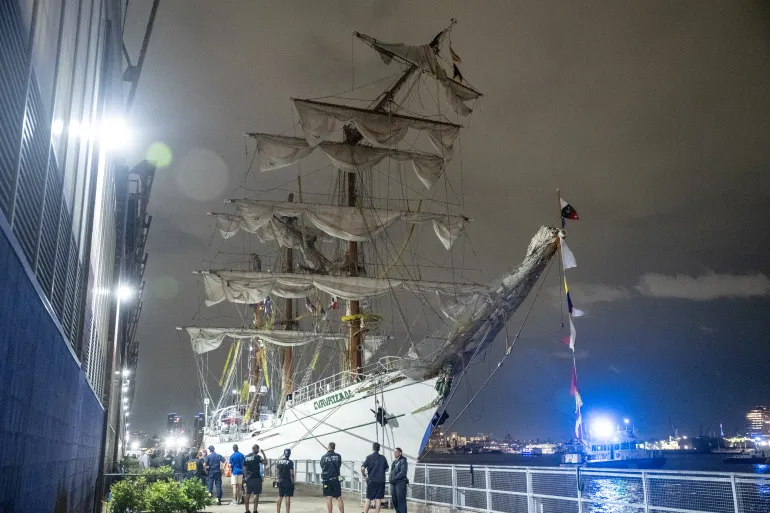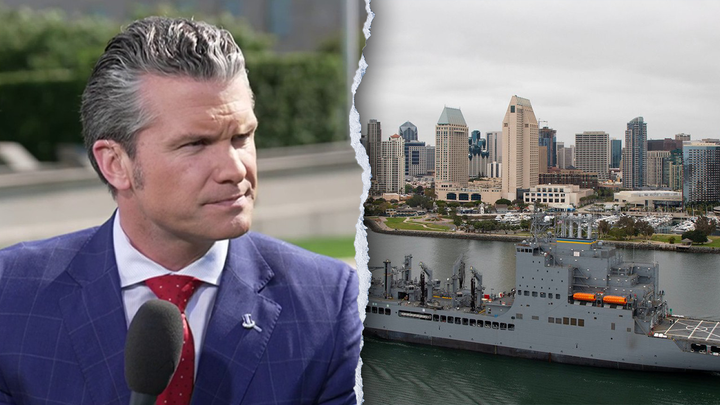
Mexican Navy Ship Collides with Brooklyn Bridge, Leaving Two Dead and Dozens Injured
Brooklyn, NY – May 18, 2025
In a harrowing maritime incident, the Mexican Navy’s training vessel, ARM Cuauhtémoc, collided with the iconic Brooklyn Bridge on the evening of May 17, resulting in two fatalities and multiple injuries. The accident has raised serious concerns about maritime safety protocols in New York City’s busy waterways.
At approximately 8:26 p.m. EDT, the Cuauhtémoc, a 90.5-meter-long tall ship, was departing from the South Street Seaport when it experienced a power failure. Witnesses reported the ship moving rapidly in reverse before its masts struck the underside of the Brooklyn Bridge. The impact caused all three masts to snap, sending sailors scrambling and onlookers fleeing in panic.
As the vessel drifted backward, its three towering masts—each measuring up to 147 feet—struck the underside of the Brooklyn Bridge, which has a vertical clearance of just 127 feet. The force of the impact snapped the masts in multiple places, sending rigging and debris crashing down onto the deck and into the river. Screams from the crew and shouts from horrified onlookers filled the air as the emergency unfolded.
Videos circulating on social media captured the chaotic scene, with sailors seen dangling from broken rigging high above the deck. Emergency services, including the FDNY, NYPD Harbor Unit, and the U.S. Coast Guard, responded swiftly, rescuing those trapped and providing immediate medical attention.
The collision resulted in the deaths of two crew members. Additionally, 25 individuals sustained injuries, with four reported in critical condition. The injured were transported to nearby hospitals for treatment.
Despite the severity of the collision, the 142-year-old Brooklyn Bridge sustained no significant structural damage. After thorough inspections, all lanes were reopened by 10:30 p.m. EDT.
The National Transportation Safety Board (NTSB) has initiated an investigation into the incident, focusing on the mechanical failure that led to the collision. The Mexican Navy has pledged full cooperation and is conducting its own internal review.
The incident has sparked widespread concern on social media, with many questioning the safety measures in place for large vessels navigating under city bridges. The Brooklyn Bridge, with a vertical clearance of 127 feet, poses challenges for tall ships like the Cuauhtémoc, which has masts reaching up to 147 feet.
The Cuauhtémoc, commissioned in 1982, is the Mexican Navy’s most prominent training vessel. Known for its traditional sailing rig and ceremonial presence, the ship has become a symbol of diplomacy and naval pride for Mexico.
According to New York City Mayor Eric Adams, the ship was carrying 277 people at the time of the incident, including naval cadets, officers, and diplomatic guests. It had been docked in New York for several days, participating in public tours and Fleet Week festivities before embarking on the next leg of its 254-day global voyage. Mexican Navy Official Website
The ship’s mission was part of an international goodwill tour, during which it was scheduled to visit 22 ports across 15 countries. Its next destination had been Reykjavik, Iceland. However, due to the unforeseen mechanical failure, the ship never made it out of New York Harbor.
“The ship was traveling as part of a goodwill tour showcasing the strength and culture of the Mexican Navy,” Mayor Adams said during a press conference. “To have that mission interrupted by tragedy, right here at one of our city’s landmarks, is heartbreaking.”
The incident has sparked an outpouring of sympathy for the victims and their families. It has also prompted scrutiny of maritime navigation protocols in busy city waterways. Many on social media expressed shock that a tall ship would attempt to pass under a bridge with known height limitations.
Maritime experts explained that such transits are typically safe when carefully coordinated with tides and local harbor pilots. However, in this case, the ship’s sudden loss of propulsion eliminated the possibility of corrective maneuvers.
“The Brooklyn Bridge clearance is already tight for a tall ship like the Cuauhtémoc,” said retired U.S. Coast Guard Commander Paul Irving. “But it was the engine failure that made this disaster inevitable. Once you lose power in a strong current, you’re at the mercy of the river.”
As investigations continue, authorities aim to implement measures to prevent such incidents in the future. The event serves as a stark reminder of the importance of stringent safety protocols in maritime operations, especially in densely populated urban areas like Brooklyn.



